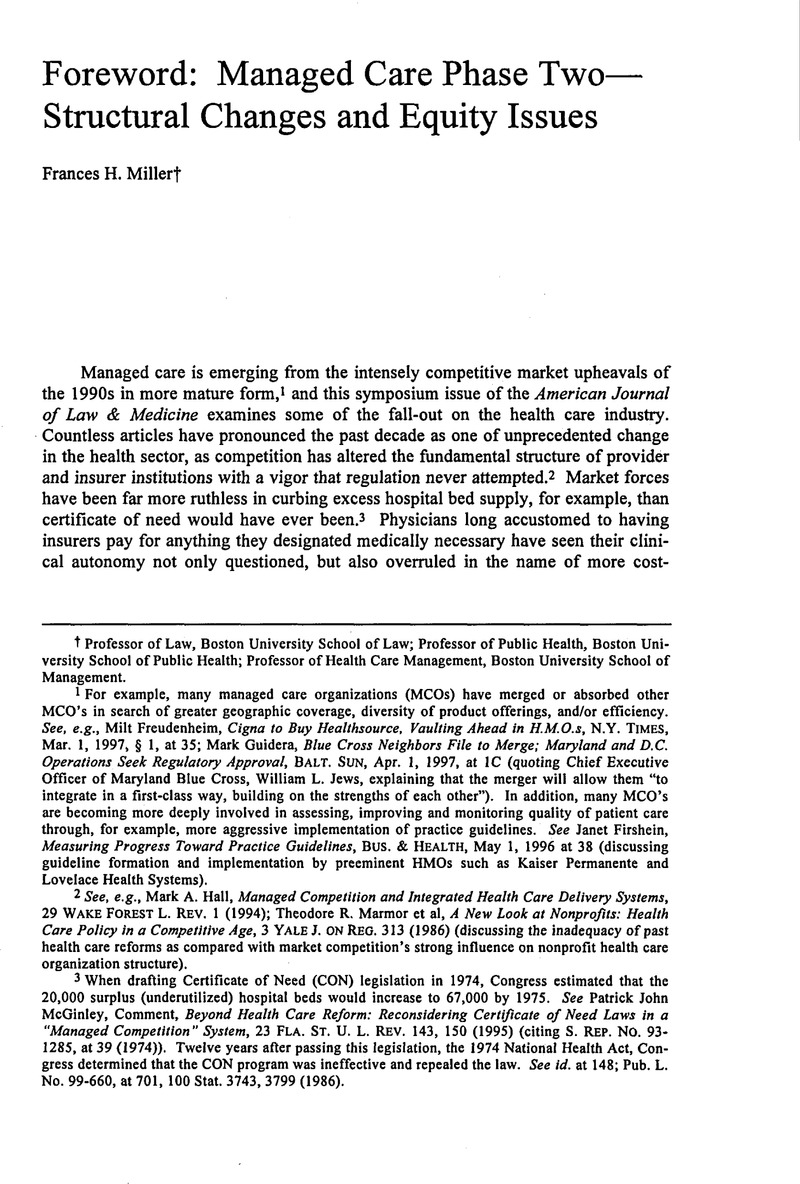No CrossRef data available.
Article contents
Foreword: Managed Care Phase Two Structural Changes and Equity Issues
Published online by Cambridge University Press: 24 February 2021
Abstract

- Type
- Other
- Information
- American Journal of Law & Medicine , Volume 23 , Issue 2-3: Managed Care Phase Two Structural Changes And Equity Issues , 1997 , pp. 188 - 190
- Copyright
- Copyright © American Society of Law, Medicine and Ethics and Boston University 1997
References
1 For example, many managed care organizations (MCOs) have merged or absorbed other MCO’s in search of greater geographic coverage, diversity of product offerings, and/or efficiency. See, e.g., Freudenheim, Milt, Cigna to Buy Healthsource, Vaulting Ahead in H.M.O.s, N.Y. Times, Mar. 1, 1997, § 1, at 35Google Scholar; Guidera, Mark, Blue Cross Neighbors File to Merge; Maryland and D.C. Operations Seek Regulatory Approval, Balt. Sun, Apr. 1, 1997, at 1CGoogle Scholar (quoting Chief Executive Officer of Maryland Blue Cross, William L. Jews, explaining that the merger will allow them “to integrate in a first-class way, building on the strengths of each other”). In addition, many MCO’s are becoming more deeply involved in assessing, improving and monitoring quality of patient care through, for example, more aggressive implementation of practice guidelines. See Firshein, Janet,Measuring Progress Toward Practice Guidelines, Bus. & Health, May 1, 1996 at 38Google ScholarPubMed (discussing guideline formation and implementation by preeminent HMOs such as Kaiser Permanente and Lovelace Health Systems).
2 See, e.g., Hall, Mark A., Managed Competition and Integrated Health Care Delivery Systems, 29 Wake Forest L. Rev. 1 (1994Google Scholar); Marmor, Theodore R. et al, A New Look at Nonprofits: Health Care Policy in a Competitive Age, 3 Yale J. ON Reg. 313 (1986)Google Scholar (discussing the inadequacy of past health care reforms as compared with market competition’s strong influence on nonprofit health care organization structure).
3 When drafting Certificate of Need (CON) legislation in 1974, Congress estimated that the 20,000 surplus (underutilized) hospital beds would increase to 67,000 by 1975. See McGinley, John Patrick, Comment, Beyond Health Care Reform: Reconsidering Certificate of Need Laws in a “Managed Competition" System, 23 Fla. St. U. L. Rev. 143, 150 (1995)Google Scholar (citing S. Rep. No. 93- 1285, at 39 (1974)). Twelve years after passing this legislation, the 1974 National Health Act, Con gress determined that the CON program was ineffective and repealed the law. See id. at 148; Pub. L. No. 99-660, at 701, 100 Stat. 3743, 3799 (1986).
5 See generally Miller, Frances H., Competition Law and Anticompetitive Behavior Affecting Health Care, 55 Mod. L. Rev. 453 (1992).CrossRefGoogle Scholar
6 See Miller, Frances H., Capitation & Physician Autonomy: Master of the Universe or Just Another Prisoner’s Dilemma? What Can Britain’s National Health Service Experience Teach Us?, 6 Health Matrix 89,101 (1996).Google ScholarPubMed




